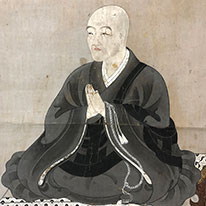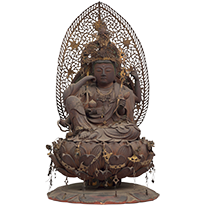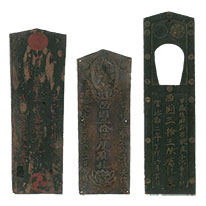General Information
The opening of the special exhibition has been postponed as part of the effort to contain the spread of COVID-19.
Special Exhibition Rescheduled
These new exhibition dates nevertheless remain subject to cancellation or change depending on the status of COVID-19 infections going forward. Updates will be posted on this website and on the museum's official Twitter feed, so please check for the latest information before visiting the museum in person. We apologize for any inconvenience.
| Exhibition Title | Special Exhibition Kannon Worship: The Thirty-three Pilgrimage Sites of Western Japan |
|---|---|
| Period | April 11–May 31, 2020 July 23–September 13, 2020 Works on view are subject to change without notice. |
| Venue | Kyoto National Museum, Heisei Chishinkan Wing |
| Transportation | JR, Kintetsu Railway, Keihan Railway, Hankyu Railway, City Bus |
| Closed | Mondays except August 10 (national holidays), 2020 | Special Exhibition Hours | 9:30 a.m.–6:00 p.m. (Entrance until 5:30 p.m.) Fridays, Saturdays: 9:30 a.m.–8:00 p.m. (Entrance until 7:30 p.m.) |
| Special Exhibition Admission | Adult 1,600 yen (1,400 yen) Univ. Student 1,200 yen (1,000 yen) High School Student 700 yen (500 yen)
|
| Educational Flyer | Find Your Favorite Manifestation of Kannon: All about the Thirty-three Pilgrimage Sites of Western Japan |
| Coloring Project | Color your own pictures of the Seven Manifestations of Kannon (the bodhisattva Avalokiteshvara), which appear throughout the Kyoto National Museum's special exhibition Kannon Worship.
Each form of the deity has a distinct appearance and powers. Find your favorite, print, and color! Images may be printed on A4 or Letter-size paper and can be used as an A6-size book or notebook cover. Shō (Noble) Kannon Eleven-headed Kannon Thousand-armed Kannon Nyoirin Kannon Horse-headed Kannon Pure Kannon Rope-snaring Kannon |
| Audio Guide |
Fee 600 yen (includes tax) Time approx. 40 min Language Japanese, English, Chinese, Korean 9:30 a.m.–5:15 p.m.(Fridays, Saturdays 9:30 a.m.–7:15 p.m.) |
| Catalogue | 2,700 yen. 310 pages. 171 objects. Color plates. Available at the Museum Shop Catalogues of Past Special Exhibitions |
| Organized by | Kyoto National Museum, Saikoku sanjūsansho fudasho kai, The Yomiuri Shimbun |
| With the support of | Shimizu Corporation, Non-Destructive Inspection Co., Ltd. |
Images from the Exhibit
The Thirty-three Pilgrimage Sites of Western Japan (J., Saikoku sanju-sansho) was purportedly established by Priest
Tokudō (dates unknown), the founder of Hase-dera Temple in Nara, in 718. According to legend, Priest Tokudō
received an oracle from the King of Hell, Enma, "Many have been sent to hell because of their evil deeds in previous
lives. Please teach people that they can acquire merit by visiting the sacred sites of Kannon (Skt., Avalokiteśvara)
and the compassionate mind of this bodhisattva." He was then bestowed a written pledge and thirty-three seals in
the shape of a wish-fulfilling jewel, which were passes to birth into Buddhist paradise. The thirty-three temples that
Priest Tokudō distributed these seals became part of the belief in sacred Kannon sites and Japan's oldest pilgrimage
route, in which talismans were distributed.
The overall distance of this route extends approximately 1000 kilometers, encompassing the Kinki region
from Wakayama, Osaka, Hyogo, Kyoto, Nara, Shiga, and Gifu prefectures. The concentration of a third of these
pilgrimage sites in Kyoto, the longstanding capital of Japan and center of culture, led to the spread of belief in
Kannon and the culture of pilgrimages throughout Japan.
On the occasion of 1300 years since the founding of the Thirty-three Pilgrimage Sites of Western Japan,
this exhibition celebrates this pilgrimage in Kyoto, which has deep ties to this practice. Introduced here through
stunning images of the bodhisattva Kannon and treasures from these sites is the allure of this pilgrimage, which
attracts people even today, regardless of age, gender or nationality. On exhibit are numerous objects that have been
preserved and passed down together with belief in Kannon.
-
![National Treasure. Kokawadera engi emaki (Illustrated Legends of Kokawa-dera Temple). Kokawa-dera Temple, Wakayama. [on view: July 23–August 16, 2020]](../../../jp/theme/upload_images/1F-2_1015_tmb.png)
- National Treasure
Kokawadera engi emaki (Illustrated Legends of Kokawa-dera Temple)
Kokawa-dera Temple, Wakayama
[on view: July 23–August 16, 2020]
I. Teachings about Kannon
The Universal Gate chapter of the Lotus Sutra (J., Myōhō rengekyō, also known as Hokekyō) explains that the bodhisattva Kannon (Skt., Avalokiteśvara) appears in as many as thirty-three forms to save all people from their pains and sufferings. Because of these spiritual benefits, Kannon has engendered the faith of many since ancient times. This section introduces objects that exemplify time-honored belief in Kannon as well as the different scriptures that teach about this deity.
II. Images of Hell
The origin of the Thirty-three Pilgrimage Sites of Western Japan (J., Saikoku sanjūsansho) can be traced to a legend of Priest Tokudō, the 8th century founder of Hase-dera Temple, who fell into hell during a state of temporary death. There he encountered Enma, the King of Hell, who asked the priest to propagate the merits of Buddhist pilgrimages. Though people throughout history have looked to Kannon for salvation from hell, no one really knows what kind of place this realm is. The paintings such as The Six Realms (J., rokudō-e), based on the Buddhist idea of Six Realms of Transmigration, and related works such as Tale of Hungry Ghosts in this section vividly show us what our predecessors imagined hell to look like.
-
![National Treasure. Yamai no sōshi (Diseases and Deformities). Bad Breath. Kyoto National Museum. [on view: July 23–August 16, 2020]](../../../jp/special/img/20200411/skk_2-2_20200411_tmb2.jpg)
-
National Treasure
Yamai no sōshi
(Diseases and Deformities)
Bad Breath
Kyoto National Museum
[on view: July 23–August 16, 2020]
-
![National Treasure. Rokudō-e (Six Realms of Birth). Shōju Raigō-ji Temple, Shiga. [this scroll on view: August 18– September 13, 2020]](../../../jp/special/img/20200411/skk_2-1_20200411_tmb2.jpg)
-
National Treasure
Rokudō-e
(Six Realms of Birth)
Shōju Raigō-ji Temple, Shiga
[this scroll on view: August 18– September 13, 2020]
III. The Beginning of the Sacred Sites
Little is known about the beginning of the Thirty-three Pilgrimage Sites of Western Japan. In addition to Priest Tokudō, the Cloistered Emperor Kazan (r. 984–986), and Priest Shōkū (910–1007), who founded Engyō-ji Temple in 966, were also purportedly instrumental in the establishment of these sacred sites. This section features portraits of these historic figures. Also highlighted are the origin tales of the thirty- three temples, such as the illustrated handscroll Legends of Kokawa-dera Temple, which depicts the founding of Kokawa-dera and the miracles of the Thousand-armed Kannon, the temple's main object of veneration.
Ⅳ. Visualizing Sacred Sites
The pilgrimage to the thirty-three temples in Western Japan, which was primarily practiced by monks in training and mountain ascetics, gradually spread to all levels of society. Over time, warriors and commoners alike partook in this pilgrimage. Rooted in the devotion of such individuals, this practice was effective for soliciting donations to reconstruct temple buildings that were destroyed in natural disasters or in wars. This section features works, such as pilgrimage mandalas (J., sankei mandara) and solicitation letters, which played a vital role in welcoming new pilgrims and providing easy-to-understand explanations of each temple's history and merits.
-
![Sefuku-ji Temple Pilgrimage Mandala. Sefuku-ji (Makinoo-dera) Temple, Osaka. [on view: August 18– September 13, 2020]](../../../jp/special/img/20200411/skk_4-1_20200411_tmb.jpg)
-
Sefuku-ji Temple Pilgrimage Mandala
Sefuku-ji (Makinoo-dera) Temple, Osaka
[on view: August 18– September 13, 2020]
-
![Important Cultural Property. Kōfuku-ji Temple Mandala. Kyoto National Museum. [on view: August 18– September 13, 2020]](../../../jp/special/img/20200411/skk_4-2_20200411_tmb.jpg)
-
Important Cultural Property
Kōfuku-ji Temple Mandala
Kyoto National Museum
[on view: August 18– September 13, 2020]
V. Forms of Prayers and Devotion
The temples of the Thirty-Three Pilgrimage Sites of Western Japan that issue talismans have as their main image of devotion one of the seven forms of Kannon (Skt., Avalokiteśvara): Noble Kannon, Eleven-headed Kannon, Thousand-armed Kannon, Horse-headed Kannon, Wish-fulfilling Kannon, Purity Kannon, and Unfailing-rope Kannon. These seven forms of this deity conform to the Six Kannon, who emerged from the concept of the Six Realms of Transmigration, indicating that these forms are connected to the development of the sacred Kannon sites. This section features different forms of devotion through statues and paintings of Kannon, to who people regardless of class from ancient times to this day have continued to earnestly offer prayers.
VI. Traces of the Pilgrimage
Aspects other than purely religious ones came to be associated with the pilgrimage to the Thirty-three Sites of Western Japan as it began to spread socially and regionally. A prime example of this has been the treatment of the journey as an excursion, which has attracted people of all classes and backgrounds and which has been bustling with activity. Though the purpose may differ, the act of putting one's hands together and offering prayers to Kannon, the main object of devotion at each site, has remained unchanged and continues to be practiced to this day. This section presents historic publications made for the many pilgrims as well as religious artifacts they wore and offered.
VII. Inherited Treasures
Scholars believe that the Thirty-three Pilgrimage Sites of Western Japan developed as sacred places of Kannon worship in the Heian period (794–1185), during the first half of the twelfth century. The thirty-three temples associated with the pilgrimage, however, do not necessarily share a common history or come from the same Buddhist sects. The various treasures from each of these ancient temples also do not simply fall into categories of "Kannon belief" or "Thirty-three Pilgrimage Sites. "This section explores these treasures, which have survived tumultuous changes and circumstances over time through the efforts of our predecessors.
-
![National Treasure. Hokke ippongyō (Lotus Sutra Copied in Single Volume per Chapter), Chapter 25 (From the scriptures of Hasedera Temple). Hase-dera Temple, Nara. [on view: August 18– September 13, 2020]](../../../jp/special/img/20200411/skk_7_20200411_tmb.jpg)
-
National Treasure
Hokke ippongyō
(Lotus Sutra Copied in Single Volume per Chapter), Chapter 25
(From the scriptures of Hasedera Temple)
Hase-dera Temple, Nara
[on view: August 18– September 13, 2020]











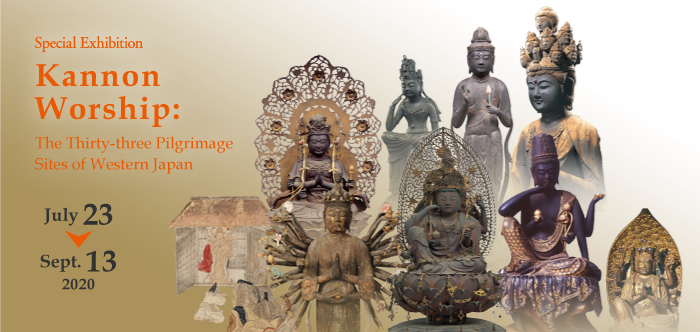
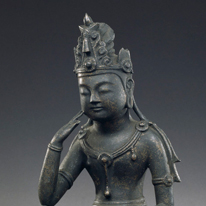
![National Treasure. Segment of Dhāraṇī of the Thousand-armed, Thousand-eyed Bodhisattva(Genbō Dedicatory Sutra). Kyoto National Museum. [on view: July 23–August 16, 2020]](../../../jp/special/img/20200411/skk_1_20200411_tmb.jpg)
